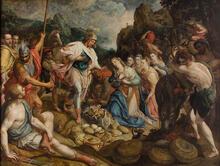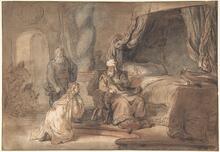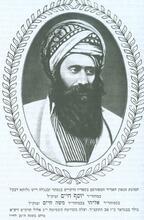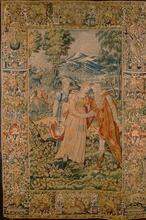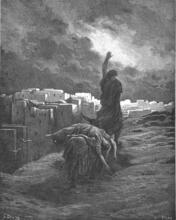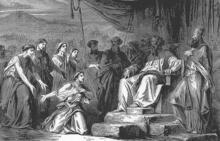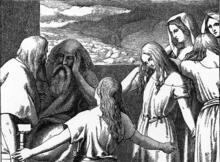Merab: Bible
Merab, one of the daughters of King Saul, is originally offered in marriage to David, whom Saul hopes to have killed. However, Saul’s plan fails, and Merab marries another man, while David marries Merab’s younger sister. The story of Saul’s attempt to arrange Merab’s marriage shows the social structures between fathers and daughters among the ancient Israelites and forms a part of Saul’s narrative as he reaches the end of his reign.
Article
Merab is the older of two daughters, the other being Michal, of King Saul (reigned c. 1025–1005 B.C.E.) according to the genealogical summary presented in 1 Sam 14:49. She is also one of six children by his primary wife, Ahinoam the daughter of Ahimaaz (compare 1 Sam 31:2, 1 Chr 8:33; 9:39; these note the fourth son, Abinadab, who is not mentioned in 1 Sam 14:49). The genealogical summary serves two functions in the larger narrative of Saul. First, it helps signal the effective end of his reign as king on the eve of his rejection by God as part of a general summary of his accomplishments to that point in his career; second, it introduces the names of family members (with the exception of Abinadab) who will appear in the remaining portion of the narrative.
In the Masoretic version (the standard Hebrew version) of 1 Sam 18:17–19, Saul is depicted to have offered Merab in marriage to David in order to make him a soldier for life and thus get him killed by the Philistines. His plan to kill David helps further develop the story line. It shows Saul trying to thwart the divine plan, which calls for David to succeed him on the throne instead of his eldest son, Jonathan. Saul’s plan does not work, however; at the appointed time of the marriage to David, Merab is wed to Adriel of Meholah instead.
Although no explicit reason for the failed marriage is given, it is implied in the ensuing narrative that David was unable to raise the money for the bride price. His initial statement in 18:18 of being from a different socioeconomic class when offered Merab as bride is made more explicit when he is offered Saul’s second daughter, Michal: “I am a poor man and of no repute” (18:23). With the second marriage offer, David is allowed to present one hundred Philistine foreskins for the normal marriage gift, substituting military prowess for social standing. In ancient Israelite society, daughters were under the legal custody of their fathers, and marriages were used regularly as a way of strengthening a father’s social or economic position or, as in this case, as a way for royalty or the elite to pursue political interests.
Another ancient version of 1 Samuel, Codex Vaticanus of the Greek version, which is earlier in date than the Masoretic version and which reflects a different form of the book, does not include the story of 1 Sam 18:17–19. A later scribe may have composed the story in order to show that the eldest daughter was married first, according to custom. He would have derived the name of Merab’s husband from the Greek version of 2 Sam 21:8, which reports how David tried to strengthen his claim to the throne of Israel by killing off Saulide heirs who could challenge him by virtue of their royal blood. The Masoretic version also differs from the Greek version (LXX) in the story of the “five sons” of Michal or Merab, who are handed over to the Gibeonites to be sacrificed (2 Sam 21:8).
Adelman, Rachel. “Michal: The King's Daughter or the King's Wife.” In The Female Ruse: Women's Deception and Divine Sanction in the Hebrew Bible, 137-150. Sheffield: Sheffield Phoenix Press, 2015.
Edelman, Diana V. King Saul in the Historiography of Judah. Sheffield, England: 1991.
Kalmanofsky, Amy. “Michal and Merab.” In Dangerous Sisters of the Hebrew Bible, 37-52. Minneapolis: Augsburg Fortress Press, 2014.
Meyers, Carol, General Editor. Women in Scripture. New York: 2000.
Steinberg, Naomi. “Kinship and Gender in Genesis.” Biblical Research 39 (1994): 46–56.

